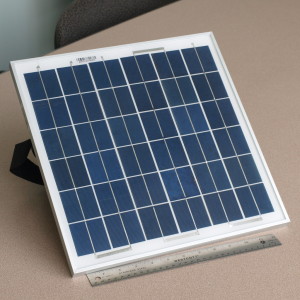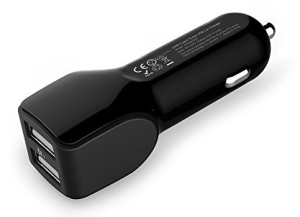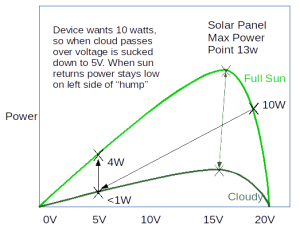Can I use a Solar panel to charge my phone or tablet?
 There is a lot of interest in charging tablets and phones directly from a solar panel, without the expense of an external battery and charge controller. We’ve done some testing on a variety of phones and several tablets that charge over a micro-USB connector at 5 V to determine what is practical.
There is a lot of interest in charging tablets and phones directly from a solar panel, without the expense of an external battery and charge controller. We’ve done some testing on a variety of phones and several tablets that charge over a micro-USB connector at 5 V to determine what is practical.
We tested using one of our 12-V, 15-W Solartec panels and two different USB car chargers, one from Aukey, and the other from Anker. The car chargers are essentially dc-dc buck converters, and both operated similarly. We chose models that were rated for 12 V to 24 V, so the open circuit panel voltage of 21 V wouldn’t damage them.
The Bottom Line
A 12-V panel with dc-dc converter doesn’t work well for most devices, and this setup is not recommended. However, most phones, and some tablet devices will charge nicely from a solar panel rated 5 V, and 5 W or more. Some tablets will need a panel rated over 10 W or they won’t charge. The characteristics of a “12-V” panel used with a dc-dc converter cause problems. (See below.)
The Technical Details
We can’t make any universal statements about the useability of direct solar charging because it all depends on the design details of the power circuits inside your phone or tablet, and manufacturers don’t publish the technical details you need to know. Generally speaking, many phones will charge nicley from a solar panel, and a minority of tablets will also.
A problem arises when the amount of power available from the panel is less than the device requires. Depending on how the device has been engineered, there are three possibilities:
- The device will continue charging at slightly reduced voltage, using whatever current is available.
- The device will stop charging, and not retry until power is completely disconnected and reconnected.
- The device will repeatedly attempt to charge and quit in a several-second-long cycle.
A lot of phones do #1 or #3, which works fine if they have their own dedicated panel. If a cloud passes over, they will continue charging when the sun comes back out. Many tablets and most Apple devices seem to do #2, which makes charging directly from a solar panel unworkable. An electronic device which cuts the power for a second about once every minute might make such devices charge reliably, but I know of no inexpensive devices which would perform this function.
The problem with using a dc-dc converter to produce 5 V from a 12-V solar panel
 We recommend you do not try and use a 12-V panel to charge 5-V phones or tablets. Here’s why:
We recommend you do not try and use a 12-V panel to charge 5-V phones or tablets. Here’s why:
A “12-V”, 15-W solar panel puts out about 13 W under typical conditions, but this is at the max power point of 15 V or so. Below the max power point voltage, the panel acts like a constant current source, so the power curve drops linearly as the voltage drops. The power curve looks like the green line, with a big hump around 15 V. Under full sun, a dc-dc converter can easily provide 2 amps at 5 V, (10 W) and the panel is operating to the right of the max power point. This works fine until a cloud passes over. Now the panel’s power curve looks like the dark green line; it can’t produce the 10 W the device wants. The device keeps charging at whatever amperage the panel can supply (~0.1 A) which pulls the panel voltage all the way down to 4.9 V. At 4.9 V, the panel is now operating at a voltage way below it’s max power point, and even when full sunlight returns, at ~5 V the max amperage the panel can create is about 0.8 A; the device is taking all the power the panel can produce and the panel voltage never gets a chance to climb back over 15 V. The device will continue charging at 5 V, 0.8 A = 4 watts, instead of 10 W. The panel needs to be disconnected briefly and reconnected in order for the voltage to return to the high side of the power hump. A solar panel with it’s max power point at 5 V will not have this problem. I would recommend something like the X-Dragon 5V14W panels for charging tablets.